Past Exhibits
Little Treasures
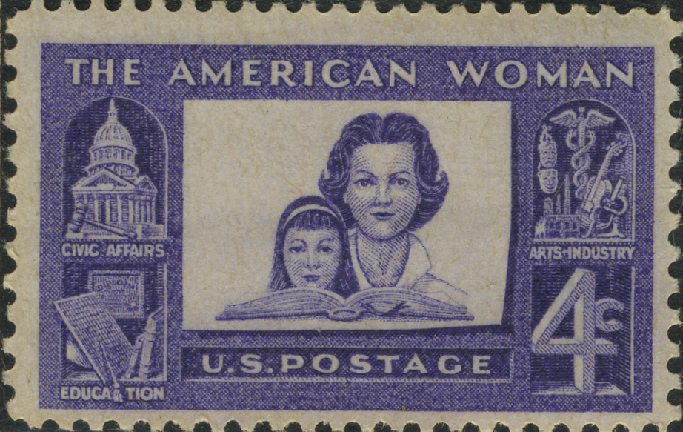
A seemingly disparate group of items from the BHS archivial collection come together in a small display located in the Board Room of the Castle. The grouping of these objects have several common bonds. The most obvious is their small stature. They are inherently precious as a certain degree of closeness is required in order to inspect them. They are cherished for the memories they hold for some, the nostalgia they evoke in others; and perhaps fascination for those unfamiliar with them. All of these objects were donated by community members who understood that something can be learned about the history of Bayside through these common, everyday objects.
United States Postage Stamp - "American Woman", 1960
Created by Baysider Robert Sivard. The artist lived with his parents at 38-22 212th Street, attended PS 41, and Flushing High School (as Bayside High School was not yet bulit), and was an acclaimed international artist who also served as chief of visual information services at the U.S. Embassy in Paris, France.
Bayside Life: On the Edge of Modernity
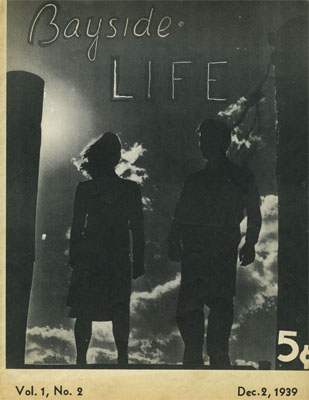
Bayside Life: On the Edge of Modernity offers a close-up look at the little village that was becoming a town prior to the U.S. ’s entry into the Second World War, as captured in the pages of Bayside Life. Published between 1939 and 1941, this short-lived magazine sought to promote a sense of community, hometown pride, and neighborhood spirit, by focusing on local achievements and happenings at the exclusion of world affairs. Both literally and metaphorically on the edge of change, Bayside was experiencing a population explosion, massive home construction, and travel made easier by the opening of the Cross Island Parkway, Whitestone Bridge, LaGuardia Airport. The New York World’s Fair contributed to an atmosphere heady with optimism following America ’s Depression years. Yet, at the same time, war was declared in Europe and Bayside residents pined for a time when neighbors knew each other and life was less complicated.
Perspectives of Queens: Drawings by Joe LoGuirato

This exhibit showcases historically significant structures in Queens through a series of drawings by artist Joe LoGuirato. Spotlighting the borough’s architectural heritage, the 16 drawings depict structures within Queens that are either NYC designated landmarks or are worthy of adding to that list. Sites depicted include: the Jamaica Savings Bank (Jamaica Avenue and 161 Street); Republican Club (Lefferts Boulevard in Richmond Hill); Grace Church (Jamaica Avenue in Jamaica); Hell Gate Bridge (connecting Ward’s Island to Astoria); the Poppenhusen Institute (College Point); Sidewalk Clock (Jamaica Avenue and 161 Street); Elk's Club (Queens Boulevard); Union Church (Astoria); Town Hall (Flushing); Ahles House (39 Avenue and 213 Street in Bayside); the Stone House (35 Avenue and Bell Boulevard in Bayside), and Ridgewood Theater (Myrtle Avenue); among others. LoGuirato is a native New Yorker who derives inspiration from the city’s streets, skyline and array of building facades and architectural details. These elements are repeatedly reflected in his work. The Art Director for the Office of Communications at Brooklyn College and an Adjunct Professor in the Art and Design Department of New York City College of Technology, LoGuirato holds a BFA from Queens College and an MA from Brooklyn College. He has had four one-person exhibits, and has participated in many group shows throughout the metropolitan area, including the 2008 Celebration of the Arts at BHS in which he won second prize.
Trolleys of the North Shore
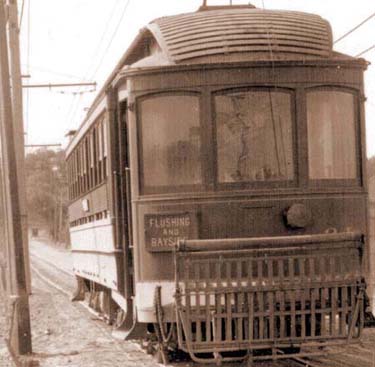
Clang Clang Clang Went the Trolley!
At the turn of the century every town and village in the United States had a trolley that ran down its main street. While most of us don't remember those brightly colored cars, we can all identify with Judy Garland hoping aboard one in the motion picture Meet Me in St. Louis and singing the "Trolley Song". Trolley cars are as much a part of American nostalgia as apple pie.
Few people know that around 1911 a resident of Whitestone or Flushing could travel all the way to Hicksville by way of the New York & North Shore Traction Company's fleet of trolleys. The main line paralleled old Broadway, now Northern Boulevard, passing through Bayside, Douglaston, Little Neck and on to Mineola via Manhasset and Roslyn. There were also branches to Port Washington and Hicksville. The private automobile and New York City's refusal to allow a fare increase doomed the trolley line to abandonment in 1923.
Rolf Armstrong: Artist in Residence
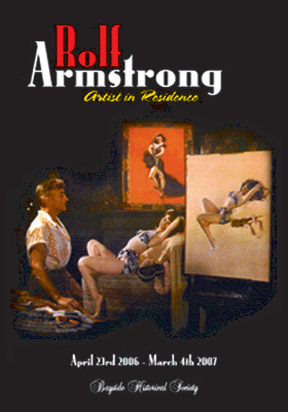
Often called the “Father of the American pin-up girls,” Rolf Armstrong possessed two powerful personae. One was the incredibly successful artist whose extraordinary images helped define glamour through four decades, and the other was the avid sailor frequently seen on the waters of Little Neck Bay. His Bayside home, nicknamed Basque Casa, was a magnificent piece of architecture, which he considered his greatest work.
Bayside Was a Wilderness Then
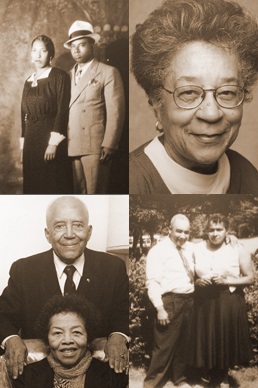
The origin of "Bayside Was a Wilderness Then - Voices from the Black Community" dates back to 1988. Members of the Bayside Historical Society formed a committee and set out to meet and interview longtime residents of Bayside's Black Community. During those talks, shared memories were transcribed and printed in a publication by the same name. A small exhibit at Fort Totten was designed to accompany the project.
Fourteen years later a newly formed local committee with strong ties to Bayside's Black Community returned to search for and collect yet another group of reminiscences. These new recollections helped to preserve the rich culture of a diminishing population whose many contributions have enriched the community of Bayside.
Most of the individuals who participated in this new exhibit live in the area of Bayside which is bordered by Northern Boulevard on the north, Francis Lewis Boulevard on the west, Bell Boulevard on the east and 48th Avenue on the south. A few others come from the area near Crocheron Park and Public School 41.
We are indebted to those who willingly agreed to participate in the new project, entitled "Bayside Was a Wilderness Then - Voices from the Black Community. . . Revisited" We are extremely pleased that the new interviews were recorded, transcribed and combined into a new publication. Our thanks go to the following participants for their lively, descriptive and honest accounts of their experiences living in a Bayside of earlier and simpler times.